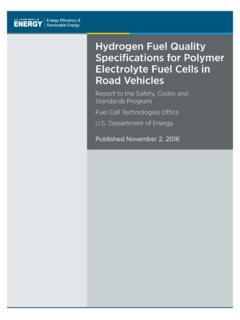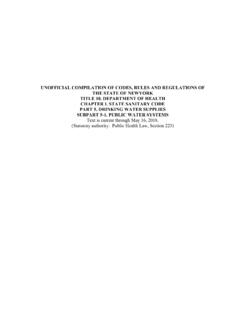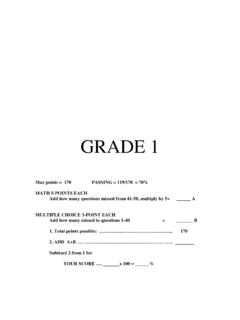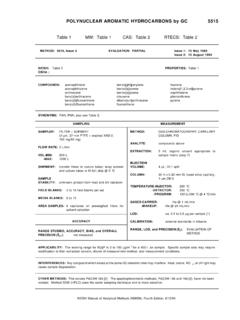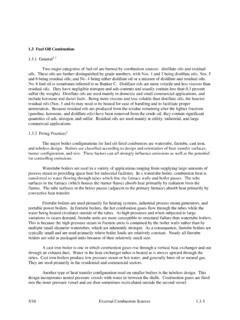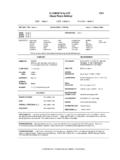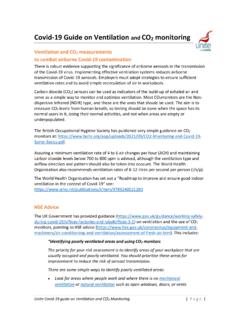Transcription of plain english guide par75 final rule
1 plain english guide to the Part 75 Rule Environmental Protection Agency Clear Air Markets Division 1200 Pennsylvania Avenue, NW Washington, DC 20460 June, 2009 i TABLE of CONTENTS Page SECTION : 1 What is the purpose of this guide ? .. 1 What is Part 75 and who must comply with it? .. 1 What is a cap and trade program? .. 4 Why is continuous monitoring necessary?.. 5 How is the Part 75 rule structured? .. 5 What other Federal regulations interface with Part 75?
2 7 SECTION : OVERVIEW OF PART 75 MONITORING 8 Register the Affected Unit(s) with EPA .. 9 Select a Monitoring Methodology .. 9 Install and Certify Monitoring Systems .. 13 Monitor and Record Emissions Data .. 13 Conduct Quality Assurance/Quality Control Procedures .. 15 Maintain Records .. 15 Report Emissions .. 16 SECTION : BASIC CONTINUOUS MONITORING 18 What is a continuous emission monitoring system (CEMS)?.. 18 Primary and Backup Monitoring Systems .. 21 How must a CEMS be operated? .. 22 How are emissions and heat input rates determined from CEMS data? .. 22 When are corrections for stack gas moisture content required?
3 23 What if a unit has multiple stacks or shares a stack with other units? .. 26 What are the missing data procedures for CEMS? .. 26 SECTION : APPENDIX D METHODOLOGY FOR GAS-FIRED AND OIL-FIRED 27 What is a gas-fired or oil-fired unit?.. 27 What is the Appendix D monitoring method? .. 28 ii Page How is the fuel flow rate measured?.. 28 What are the fuel sampling requirements of Appendix D?.. 29 How is the SO2 mass emission rate calculated?.. 31 How is the unit heat input rate calculated? .. 31 Which sulfur content, GCV and density values are used in the calculations?.. 32 What are the on-going quality-assurance requirements of Appendix D?
4 34 What are the missing data procedures for an Appendix D unit? .. 35 SECTION : APPENDIX E METHODOLOGY FOR GAS-FIRED AND OIL-FIRED PEAKING UNITS .. 36 What is a peaking unit? .. 36 How is an Appendix E correlation curve derived? .. 37 How are hourly NOx emissions determined? .. 38 What are the fuel sampling requirements of Appendix E? .. 39 What are the on-going quality-assurance requirements of Appendix E?.. 39 What are the missing data procedures for an Appendix E unit? .. 41 What happens if an Appendix E unit loses its peaking unit status?.. 41 SECTION : LOW MASS EMISSIONS METHODOLOGY .. 42 Description of the 42 What is a low mass emissions (LME) unit?.. 42 How does a unit qualify for LME status?
5 43 How are emissions and heat input calculated for an LME unit? .. 45 How are site-specific default NOx emission rates determined for an LME unit ? .. 47 Which site-specific default NOx emission rates are used for reporting? .. 49 What are the recordkeeping and reporting requirements for LME units? .. 50 What are the on-going QA/QC requirements for LME units? .. 51 What happens if a low mass emissions unit loses its LME status?.. 52 SECTION : PART 75 MONITORING SYSTEM CERTIFICATION 53 How are Part 75 monitoring systems certified? .. 53 Step 1 Submit an Initial Monitoring Plan .. 53 Step 2 Submit Certification Test 55 Step 3 Conduct Certification 55 Step 4 Submit Certification Application.
6 58 iii Page Step 5 Receive Agency Approval or Disapproval .. 59 What reference test methods and standards are used for certification testing ? .. 59 What performance specifications must be met for certification?.. 60 What is meant by the span value , and why is it important? .. 63 Recertification and Diagnostic 65 SECTION : QUALITY ASSURANCE AND QUALITY CONTROL (QA/QC) 67 Does Part 75 require periodic quality QA/QC testing after a monitoring system is certified? .. 67 What are the on-going QA test requirements in Part 75 for units reporting emissions data year-round?
7 67 Are there any exceptions to these basic QA test requirements? .. 69 Are there any special considerations when performing these basic QA tests ? .. 70 What are the on-going QA test requirements for ozone season-only reporters ? .. 72 What performance specifications must be met for the routine QA tests required by Part 75? .. 73 Are there any notification requirements for the periodic QA tests? .. 75 What are the essential elements of a Part 75 QA/QC program? .. 75 SECTION : MISSING DATA SUBSTITUTION 77 Does Part 75 require emissions to be reported for every unit operating hour ?.. 77 How are emissions data reported when a monitoring system is not working ? .. 77 What are the Part 75 missing data procedures for CEMS?
8 79 What are the missing data procedures for Appendices D, E, and G? .. 81 What is conditional data validation? .. 83 SECTION : PART 75 REPORTING 85 What are the basic reporting requirements of Part 75? .. 85 How does EPA evaluate the electronic reports? .. 86 Part 75 Audit Program .. 87 Page iv APPENDIX A: Part 75 Monitoring Requirements for Common Stack and Multiple Stack Configurations .. 89 APPENDIX B: On-Going QA Test Requirements for Ozone Season-Only Reporters.
9 99 APPENDIX C: 103 v ACRONYMS AGA - American Gas Association API - American Petroleum Institute ARP - Acid Rain Program ASME - American Society of Mechanical Engineers ASTM - American Society of Testing and Materials BAF - Bias Adjustment Factor CAIR - Clean Air Interstate Regulation CAMD - Clean Air Markets Division CAMR Clean Air Mercury Regulation CDV - Conditional Data Validation CEM - Continuous Emission Monitoring CEMS - Continuous Emission Monitoring System CFR - Code of Federal Regulations CO2 - Carbon Dioxide DAHS - Data Acquisition and Handling System DP - Differential Pressure DR - Designated Representative ECMPS Emissions Collection and Monitoring Plan System EDR - Electronic Data
10 Reporting EGU - Electric Generating Unit viEPA - Environmental Protection Agency ETS - Emissions Tracking System GCV - Gross Calorific Value GHR - Gross heat Rate GPA - Gas Processors Association Hg - Mercury ISO - International Organization for Standardization LME - Low Mass Emissions MCR Maximum Controlled Emission Rate MDC - Monitoring Data Checking MER - Maximum Potential Emission Rate (MER) MPC Maximum Potential Concentration NBP - NOx Budget Trading Program NIST - National Institute of Standards and Technology NSPS - New Source Performance Standards NOx - Nitrogen Oxides O2 - Oxygen OOC - Out-of-Control PLC - Programmable Logic Controller PMA - Percent Monitor Data Availability PNG - Pipeline Natural Gas QA/QC - Quality Assurance/Quality Control viiRA - Relative Accuracy RATA - Relative Accuracy Test Audit RM - Reference method SIP - State Implementation Plan SO2 - Sulfur Dioxide TTFA - Targeting Tool for Field Audits WAF - Wall Effects Adjustment Factor UNITS of MEASURE Btu - British thermal unit dscfh - Dry standard cubic feet per hour dscf/mmBtu - Dry standard cubic












